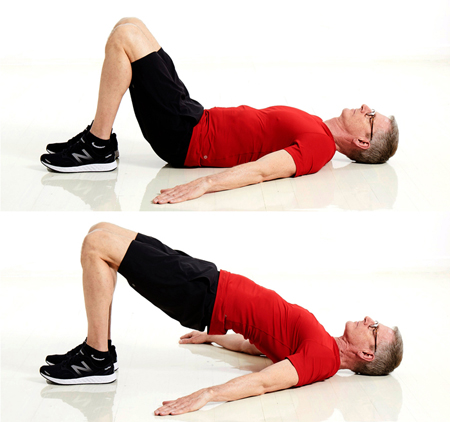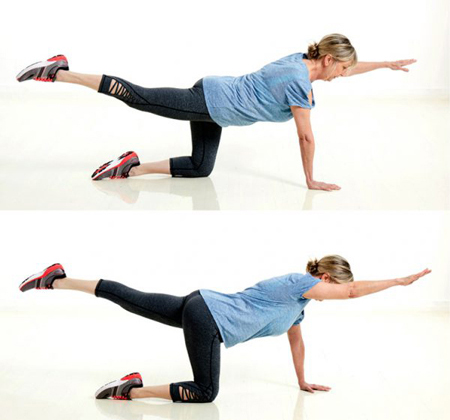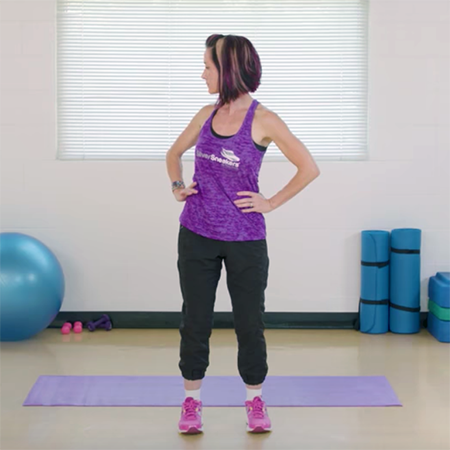The Best and Worst Exercises for Lower Back Pain
Prevent and relieve back pain with this helpful guide to exercise for the back.

If you’re reading this, you’ve probably dealt with back pain. In fact, most of us have—or will. Research shows more than 80 percent of the population will experience lower back pain at some point in their lives.
“Lower back pain is often a result of our lifestyles,” says Maxine Yeung, R.D., a personal trainer and founder of The Wellness Whisk. A few of the causes: poor posture, sitting most of the day, being overweight or obese, and lack of adequate physical activity, she says.
Getting older doesn’t help. “As we age, our bones and discs begin to degenerate,” Yeung says, “which can increase our risk of developing osteoarthritis, bulging discs, and spinal stenosis.”
No matter the cause, you don’t have to sit back and endure the pain. Incorporating certain exercises into your routine—and steering clear of others—can improve your symptoms.
Here are the dos and don’ts of working out to protect your back. As always, safety is key. The exercises here may be different or more advanced than those you’ll experience in a SilverSneakers class. If you have a chronic condition (including osteoporosis), balance issues, or injuries, talk to your doctor about how you can exercise safely.
The Best Exercises for a Bad Back
Anyone suffering from back pain or stiffness should work to improve both their strength and flexibility, says Lisa Woods, a personal trainer and yoga teacher in Eagle, Colorado.
When it comes to building strength, Woods recommends focusing on your core. “Doing abdominal exercises can be very helpful in reducing back pain because it provides support to the spinal muscles,” she says.
But remember: Your core extends far beyond your abs. The exercises below help strengthen the core muscles in your back too.
1. Seated Row

Tie a resistance band around your feet when you’re seated with legs extended and your back straight. Grab the two ends of the band, palms facing each other, and extend your arms forward.
Pull the band straight back until your hands reach the sides of your ribs, squeezing your shoulder blades together as you do so. Pause, then slowly extend your arms to return to starting position. Aim for three sets of 10 reps.
2. Pelvic Tilt

Lying on your back, bend both knees and place feet flat on the floor hip-width apart. Flatten your lower back against the floor by tightening your abdominal muscles and bending your pelvis up slightly. Hold for up to 10 seconds, then release. Repeat for 10 to 12 reps total.
3. Bridge Pose

Lie on your back with knees bent, feet flat on the floor about hip-width apart, and heels a few inches away from your buttocks. Press your arms into the floor for support, and brace your core to minimize the arch in your lower back.
Push through your heels and squeeze your glutes to lift your hips up until your body forms a straight line from your knees to shoulders. Hold this position for four to eight breaths. Slowly lower your hips to return to starting position. Repeat for three to five reps total.
4. Bird Dog Pose

Start on your hands and knees with your palms flat on the mat or floor and shoulder-width apart. Your neck should be in line with your back, and your gaze should be down or slightly forward.
Brace your core, and raise your left arm and right leg until they’re in line with your body. Hold for five to 10 seconds, and then return to the starting position. Repeat on the opposite side (right arm and left leg) to complete one rep. Aim for five to seven reps total.
Make it easier: Keep your hands on the floor, and only extend your leg.
5. Other Core Workouts
Like working out on your own but can’t get down on the floor? No problem. Try this 10-minute seated core workout.
Prefer group fitness classes? Many SilverSneakers classes emphasize core strength. Pilates and barre classes are also great for the core, Yeung says. Exercises can often be customized for your needs. Just let the instructor know of any conditions or back issues in advance.
Don’t Forget Flexibility
Developing core strength is key for protecting your back, but it’s only one part of the pain-free puzzle. “The ideal exercise routine for a bad back combines strength-building exercises with flexibility training,” Woods says. “Improving flexibility can boost range of motion and balance, both important factors in injury prevention.”
And consistency is key. “Often, I see people have an injury, do physical therapy, feel better, and then stop with their exercises because they think they’re fixed,” Yeung says. That’s a bad idea. To prevent relapse, you’ll want to keep up the strength and flexibility exercises.
Luckily, many group fitness classes, like SilverSneakers and yoga, include flexibility training. You can also stretch on your own.
Woods recommends the following two exercises. If you have chronic back pain, back injuries, or degenerative disc disease, it’s best to do them under the guidance of an experienced instructor.
Subscribe to our newsletter
It's quick and easy. You could be one of the 13 million people who are eligible.
Already a member? Click to discover our 15,000+ participating locations.
Follow Us
1. Gentle Twist

Stand tall with your feet hip-width apart and hands on your hips. Inhale as you lengthen the crown of your head up toward the sky. Keeping your hips facing forward, exhale and twist to the right from your belly button to your head. Gaze over your right shoulder. Hold for 10 breaths, and repeat on the opposite side.
Make it easier: Try the pose in a chair. Cross your arms over your chest, and gently twist. Hold for 10 breaths, and repeat on the opposite side.
Make it harder: Try the pose on the floor. Sit with your legs crossed in front of you. Align your head, neck, and spine. Place your right hand on the floor behind you. Bring your left hand to the outside of your right knee, gently twisting to the right. Hold for 10 breaths. Change the cross of your legs, and twist to the opposite side.
2. Modified Camel Pose

Stand with your feet hip-width apart and feet, knees, and hips facing forward. Make fists with your hands, and gently place them on your lower back, about the height of the waistband of your pants. Draw your elbows together, keeping your wrists in line with your forearms. Pull your belly in toward your spine, and lift your chest, keeping your hips level and steady. Hold for 30 to 60 seconds, and release gently.
Make it easier: Try the pose in a chair. Sit tall, reach your arms behind you, and grasp the back of a chair for a supported stretch.
Make it harder: Continue to lift your chest toward your chin as you keep your chin lifted away from your chest, finding length in the front of your body from belly button to collarbone.
The Worst Exercises for a Bad Back
Now, what shouldn’t you do? First, a general rule: Avoid any exercise that causes pain, Yeung says. More specifically, steer clear of the following:
- Contact sports or high-impact sports like running, which may aggravate back pain or result in additional injuries
- Sports that involve quick movements and twisting, such as tennis or golf, which can stress the spine
- Heavy lifting, which can escalate back pain by compressing the discs or stressing the spine
- Situps and leg lifts, which can put a lot of pressure on the lower back and may cause unnecessary straining if you lack adequate core strength
- Excessive bending like toe touches, which can place undue strain on the back
- Exercises that require forward flexion for long periods of time, such as cycling
While not recommended, if you are going to perform any of the activities above, you can help protect your back by moving slowly, engaging the abdominal muscles, and resting frequently, Woods says.
The bottom line: Developing a consistent fitness routine that combines core strengthening exercises, flexibility training, and low-impact cardio such as swimming or walking will help protect your back and alleviate pain for years to come.
Take Your Favorite SilverSneakers Classes Online!
SilverSneakers members can access live fitness classes and wellness workshops through SilverSneakers LIVE. See the latest schedule and RSVP for classes here.
Not a member? If you have a Medicare Plan, it may include SilverSneakers—at no additional cost. Check your eligibility instantly here.




